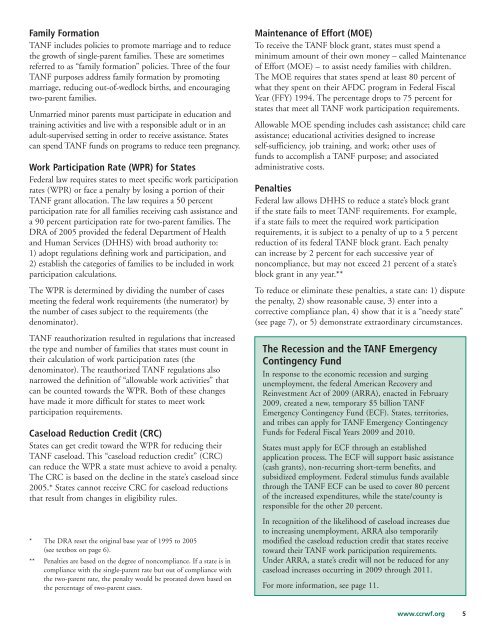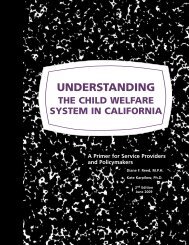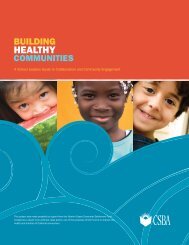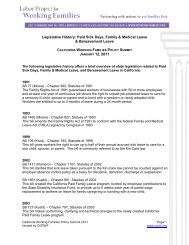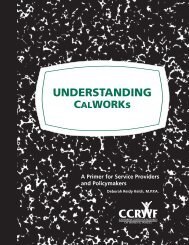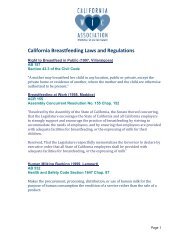Understanding CalWORKs - California Center for Research on ...
Understanding CalWORKs - California Center for Research on ...
Understanding CalWORKs - California Center for Research on ...
You also want an ePaper? Increase the reach of your titles
YUMPU automatically turns print PDFs into web optimized ePapers that Google loves.
Family Formati<strong>on</strong>TANF includes policies to promote marriage and to reducethe growth of single-parent families. These are sometimesreferred to as “family <str<strong>on</strong>g>for</str<strong>on</strong>g>mati<strong>on</strong>” policies. Three of the fourTANF purposes address family <str<strong>on</strong>g>for</str<strong>on</strong>g>mati<strong>on</strong> by promotingmarriage, reducing out-of-wedlock births, and encouragingtwo-parent families.Unmarried minor parents must participate in educati<strong>on</strong> andtraining activities and live with a resp<strong>on</strong>sible adult or in anadult-supervised setting in order to receive assistance. Statescan spend TANF funds <strong>on</strong> programs to reduce teen pregnancy.Work Participati<strong>on</strong> Rate (WPR) <str<strong>on</strong>g>for</str<strong>on</strong>g> StatesFederal law requires states to meet specific work participati<strong>on</strong>rates (WPR) or face a penalty by losing a porti<strong>on</strong> of theirTANF grant allocati<strong>on</strong>. The law requires a 50 percentparticipati<strong>on</strong> rate <str<strong>on</strong>g>for</str<strong>on</strong>g> all families receiving cash assistance anda 90 percent participati<strong>on</strong> rate <str<strong>on</strong>g>for</str<strong>on</strong>g> two-parent families. TheDRA of 2005 provided the federal Department of Healthand Human Services (DHHS) with broad authority to:1) adopt regulati<strong>on</strong>s defining work and participati<strong>on</strong>, and2) establish the categories of families to be included in workparticipati<strong>on</strong> calculati<strong>on</strong>s.The WPR is determined by dividing the number of casesmeeting the federal work requirements (the numerator) bythe number of cases subject to the requirements (thedenominator).TANF reauthorizati<strong>on</strong> resulted in regulati<strong>on</strong>s that increasedthe type and number of families that states must count intheir calculati<strong>on</strong> of work participati<strong>on</strong> rates (thedenominator). The reauthorized TANF regulati<strong>on</strong>s als<strong>on</strong>arrowed the definiti<strong>on</strong> of “allowable work activities” thatcan be counted towards the WPR. Both of these changeshave made it more difficult <str<strong>on</strong>g>for</str<strong>on</strong>g> states to meet workparticipati<strong>on</strong> requirements.Caseload Reducti<strong>on</strong> Credit (CRC)States can get credit toward the WPR <str<strong>on</strong>g>for</str<strong>on</strong>g> reducing theirTANF caseload. This “caseload reducti<strong>on</strong> credit” (CRC)can reduce the WPR a state must achieve to avoid a penalty.The CRC is based <strong>on</strong> the decline in the state’s caseload since2005.* States cannot receive CRC <str<strong>on</strong>g>for</str<strong>on</strong>g> caseload reducti<strong>on</strong>sthat result from changes in eligibility rules.* The DRA reset the original base year of 1995 to 2005(see textbox <strong>on</strong> page 6).** Penalties are based <strong>on</strong> the degree of n<strong>on</strong>compliance. If a state is incompliance with the single-parent rate but out of compliance withthe two-parent rate, the penalty would be prorated down based <strong>on</strong>the percentage of two-parent cases.Maintenance of Ef<str<strong>on</strong>g>for</str<strong>on</strong>g>t (MOE)To receive the TANF block grant, states must spend aminimum amount of their own m<strong>on</strong>ey – called Maintenanceof Ef<str<strong>on</strong>g>for</str<strong>on</strong>g>t (MOE) – to assist needy families with children.The MOE requires that states spend at least 80 percent ofwhat they spent <strong>on</strong> their AFDC program in Federal FiscalYear (FFY) 1994. The percentage drops to 75 percent <str<strong>on</strong>g>for</str<strong>on</strong>g>states that meet all TANF work participati<strong>on</strong> requirements.Allowable MOE spending includes cash assistance; child careassistance; educati<strong>on</strong>al activities designed to increaseself-sufficiency, job training, and work; other uses offunds to accomplish a TANF purpose; and associatedadministrative costs.PenaltiesFederal law allows DHHS to reduce a state’s block grantif the state fails to meet TANF requirements. For example,if a state fails to meet the required work participati<strong>on</strong>requirements, it is subject to a penalty of up to a 5 percentreducti<strong>on</strong> of its federal TANF block grant. Each penaltycan increase by 2 percent <str<strong>on</strong>g>for</str<strong>on</strong>g> each successive year ofn<strong>on</strong>compliance, but may not exceed 21 percent of a state’sblock grant in any year.**To reduce or eliminate these penalties, a state can: 1) disputethe penalty, 2) show reas<strong>on</strong>able cause, 3) enter into acorrective compliance plan, 4) show that it is a “needy state”(see page 7), or 5) dem<strong>on</strong>strate extraordinary circumstances.The Recessi<strong>on</strong> and the TANF EmergencyC<strong>on</strong>tingency FundIn resp<strong>on</strong>se to the ec<strong>on</strong>omic recessi<strong>on</strong> and surgingunemployment, the federal American Recovery andReinvestment Act of 2009 (ARRA), enacted in February2009, created a new, temporary $5 billi<strong>on</strong> TANFEmergency C<strong>on</strong>tingency Fund (ECF). States, territories,and tribes can apply <str<strong>on</strong>g>for</str<strong>on</strong>g> TANF Emergency C<strong>on</strong>tingencyFunds <str<strong>on</strong>g>for</str<strong>on</strong>g> Federal Fiscal Years 2009 and 2010.States must apply <str<strong>on</strong>g>for</str<strong>on</strong>g> ECF through an establishedapplicati<strong>on</strong> process. The ECF will support basic assistance(cash grants), n<strong>on</strong>-recurring short-term benefits, andsubsidized employment. Federal stimulus funds availablethrough the TANF ECF can be used to cover 80 percentof the increased expenditures, while the state/county isresp<strong>on</strong>sible <str<strong>on</strong>g>for</str<strong>on</strong>g> the other 20 percent.In recogniti<strong>on</strong> of the likelihood of caseload increases dueto increasing unemployment, ARRA also temporarilymodified the caseload reducti<strong>on</strong> credit that states receivetoward their TANF work participati<strong>on</strong> requirements.Under ARRA, a state’s credit will not be reduced <str<strong>on</strong>g>for</str<strong>on</strong>g> anycaseload increases occurring in 2009 through 2011.For more in<str<strong>on</strong>g>for</str<strong>on</strong>g>mati<strong>on</strong>, see page 11.www.ccrwf.org5


